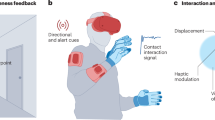Abstract
This paper presents a haptic augmented reality (AR) system that consists of a real object and a haptic device. The desired force response is achieved by the combination of the real force response of a base object and the virtual force exerted by a haptic device. The proposed haptic AR system can easily generate the force response of an object with a cheap haptic device and a base object. In the haptic AR method, how we select the base object is very important because virtual stiffness provided to users is created by modifying the reaction force profile of the base object. We compare the three method: VR method , AR method with a soft object and AR method with a hard object in the questionnaire experiment. These results show that the AR method with a soft object has better performance than the other methods.
Access this chapter
Tax calculation will be finalised at checkout
Purchases are for personal use only
Preview
Unable to display preview. Download preview PDF.
Similar content being viewed by others
References
(Lap mentor), http://www.simbionix.com/LAP_Mentor.html
(Mentice mist), http://www.mentice.com/
Wu, W., Heng, P.A.: An improved scheme of an interactive finite element model for 3d soft-tissue cutting and deformation. The Visual Computer 21(8-10), 707–716 (2005)
Ghoi, C., Kim, J., Han, H., Ahn, B., Kim, J.: Graphic and haptic modeling of the oesophagus for vr-based medical simulation. International Journal of Medical Robotics and Computer Assisted Surgery 5(3), 257–266 (2009)
Lim, Y.J., Deo, D., Singh, T.P., Jones, D.B., De, S.: In situ measurement and modeling of biomechanical response of human cadaveric soft tissues for physics-based surgical simulation. International Journal of Medical Robotics and Computer Assisted Surgery 23(6), 1298–1307 (2009)
Nagata, K., Tada, M., Iwasaki, H., Kida, Y.: Development of haptic recorder 1st report: Development of basic system. In: Proc. of the SICE System Integration Symposium, pp. 484–485 (2006) (in Japanese)
Nagata, K., Tada, M., Iwasaki, H., Kida, Y.: Development of haptic recorder 2nd report: Constructing a virtual object model based on actual measurment. In: Proc. of the SICE System Integration Symposium, pp. 11–12 (2007) (in Japanese)
Jeon, S., Choi, S.: Modulating real object stiffness for haptic augmented reality. In: Ferre, M. (ed.) EuroHaptics 2008. LNCS, vol. 5024, pp. 609–618. Springer, Heidelberg (2008)
Kurita, Y., Ikeda, A., Tamaki, T., Nagata, K., Ogasawara, T.: Haptic augmented reality interface using the real force response of an object. In: The 16th ACM Symposium on Virtual Reality Software and Technology, pp. 83–86 (2009)
Hayashi, D., Ohnishi, H., Nakamura, N.: Understand the effect of visual information and delay on a haptic display. IEICE technical report. Education technology 106(437), 7–10 (2006)
Author information
Authors and Affiliations
Editor information
Editors and Affiliations
Rights and permissions
Copyright information
© 2010 Springer-Verlag Berlin Heidelberg
About this paper
Cite this paper
Ikeda, A., Kurita, Y., Tamaki, T., Nagata, K., Ogasawara, T. (2010). Creating Virtual Stiffness by Modifying Force Profile of Base Object. In: Kappers, A.M.L., van Erp, J.B.F., Bergmann Tiest, W.M., van der Helm, F.C.T. (eds) Haptics: Generating and Perceiving Tangible Sensations. EuroHaptics 2010. Lecture Notes in Computer Science, vol 6191. Springer, Berlin, Heidelberg. https://doi.org/10.1007/978-3-642-14064-8_17
Download citation
DOI: https://doi.org/10.1007/978-3-642-14064-8_17
Publisher Name: Springer, Berlin, Heidelberg
Print ISBN: 978-3-642-14063-1
Online ISBN: 978-3-642-14064-8
eBook Packages: Computer ScienceComputer Science (R0)




